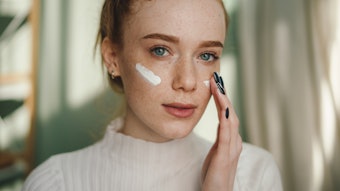The process of glycation has been well-known since the 1960s, but recent findings show more specifically how it leads to premature aging in skin.1 This research has also shown that glycation involves many macromolecules with high half-lives—similar to several proteins in dermis and some in the epidermis. It also has been found that glycation can decrease the life span of some animal species.2 In fact, glycation is related to some of greatest health issues facing humanity today, including over-exposure to UV radiation, and rising rates of diabetes and emotional stress. Research suggests one underlying similarity is their ability to produce cytotoxic reactions, induce oxidative stress and form advanced glycation end products (AGEs).
For example, in individuals with high blood sugar levels and diabetes, AGEs are formed in high quantities and cause several diseases.3 Emotional stress also directly affects the increase of oxidative stress and subsequent formation of AGEs in the body.4 Photodamage induces the synthesis of AGEs as well.5 Thus, the objective of the present study was to develop a new active ingredient to address glycation in special diabetic, elderly and xerotic panelists, and to design a method to test its benefits.
Skin Condition Considerations
Since glycation within specific skin conditions was the focus of this effort, it is first important to review some basics of these conditions relevant to developing a new treatment approach.
Diabetic skin: In recent years, high levels of AGEs were found with diabetes and other age-related diseases.3 In diabetic skin, glycation creates new molecular residues and induces cross-links in the extracellular matrix of the dermis, which contributes to altered elasticity and modifies other physical characteristics of the dermis—similar to those observed during intrinsic aging and photoaging.6 Instrumental analyses also have shown that the Maillard reaction occurs on free amino groups of Amadori phosphatidylethanolamine complex lipid membranes, and this phenomenon occurs four times more often in diabetic people.7
Xerotic skin: Xerosis is a condition of abnormal skin dryness that can be present in diabetic patients and/or those having high blood sugar, dermatitis or other ethiological causes, or those who are malnourished. The elderly are often affected by this condition. There are several potential causes of xerosis. For one, the glycation of ceramides produces glucosylceramide,8 and this reaction could generate dry skin. Other papers have also presented how glycation affects epidermal proteins.9
Elderly skin: In elderly skin, the thickness of the dermis decreases due to reductions in the synthesis of collagens I and III; the degradation of molecules via proteolytic processing, i.e., matrix metalloproteinases (MMPs); and cross-linking modifications such as non-enzymatic glycation. This is reflected in a skin as the appearance of fine lines, wrinkles and sallowness.10 Additional research has shown that carbonyl changes relate to yellowing in photoaged skin.11 This yellowing is due to the accumulation of non-enzymatic yellow-brown glycation products, characteristic of the Maillard reaction.12
In vitro Materials and Methods
Several works have shown that glycation adducts of skin proteins increase during aging. These may result from the reaction of glyoxal (GO) or methyl glyoxal (MGO) on specific protein residues, i.e., lysine, arginine, etc., causing oxidative damage. The authors therefore investigated the ability of these dicarbonyls to induce accelerated aging in dermal fibroblasts and, in turn, the efficiency of a new active to avoid it. The active of interest is based on a second generation deglycation molecule containing a specific AGE-scavenging moiety (i.e., glyoxal GO and methyl glyoxal MGO) and an antioxidant aromatic ring (imidazole).
Cell cultures and treatments: Normal human dermal fibroblasts (NHDF) were grown in Dulbecco's Modified Eagle Medium (DMEM) containing 10% bovine fetal calf serum (FCS) and supplements. Cells were not replated more than six times. For all experiments, cells were seeded in six-well plates with 5 x 104 cells per well and incubated at 37°C, 5% CO2, 95% atmospheric air and 95% humidity. After 24 hr, cells were treated with GO 0.6 mM with or without D-penicillamine (1.5 mM), as the reference deglycating agent, or an imidazole derivate at different concentrations (0.1 mM, 0.5 mM and 1 mM) for three days. The culture medium of each condition was then replaced with fresh normal medium, and cells were left for a 24-hr recovery phase.
Cellular morphology analysis: At the end of the culture, the effects of the treatments on the morphological appearance of cells were observed qualitatively using a phase contrast microscope. The cell size distribution was quantified by forward-scatter (FSC) measurements, and cell granularity distribution was determined by side-scatter (SSC) measurements, both via flow cytometer analysisa.
Modulation of intracellular pH: Increased senescent-associated β-galactosidase (SA-β-gal) activity is characteristic of senescent cells. Thus, in order to detect SA-β-gal activity, lysosomal alkalinization was induced by pretreating cell monolayers with 100 nM Bafilomycin A1 (baf A1) for 1 hr.
SA-β-gal activity: To measure SA-β-gal activity by flow cytometry, the fluorogenic substrate C12FDG was used. This compound is a membrane-permeable, non-fluorescent substrate of β-galactosidase, which after hydrolysis of the galactosyl residues, emits green fluorescence and remains confined within the cell.
Cells pretreated with baf A1 were incubated with 33 µM C12FDG and 100 nM baf A1 for 2 hr. At the end of incubation, cells were washed three times, resuspended by trypsinization, and analyzed immediately using flow cytometrya. The living cells were gated using FSC/SSC, and changes were reported as mean fluorescence intensities (MFI).
Cell cycle analysis: After culture, cells were trypsinized and approximately 1 x 106 cells/sample were centrifuged at 300 g for 5 min, fixed at 4°C for 1 hr with cold 70% ethanol, then suspended in 250 µL of a solution containing 25 µg RNase (100 µg/mL) and 12.5 µg propidium iodide (PI) (50 µg/mL). After incubation for 15 min at 37°C, 5% CO2, the samples were analyzed by flow cytometryb.
PI detection is used for cell cycle analysis. It was performed in living cells, which were selected using cell size (FSC)/granularity (SSC) parameters. This analysis determines the percentage of cells in different phases of the cell cycle, i.e., G0/G1, S and G2/M phases. Cell growth progresses during G0/G1 and S phases, and stops in the G2/M phase. An accumulation of cells in the G2/M phase therefore means they are entering senescence.
Clinical Studies
For clinical studies, three panels were assembled by a clinical and ethical committee.
Diabetic skin panel: For diabetic skin assessments, 12 diabetic women ages 30 to 65 presenting with wrinkles and dryness on their face were selected. In a blind manner, the panelists applied approx. 1 g of a test cream incorporating the imidazole derivate active at 0.16% (see Formula 1) to their entire face twice daily for one month, and measurements were made at 14 days and at the end of treatment. The control was defined as the baseline measurements of the skin. Changes in wrinkles were determined via video microscopy supported by a software system that evaluates the surface relief according to tones of grey. The results provided indices for smoothness, roughness, scaliness and wrinkles. To demonstrate changes in skin, high-resolution photographs were taken at baseline and 28 days with a 180-grade camera in a light-controlled studio.
Xerotic skin panel: To measure effects on xerosis,15 women ages 40 to 65 with xerotic facial skin were selected. In a blind manner, the panelists applied approx. 1 g of the same test cream incorporating the imidazole derivate active at 0.16% (see Formula 1) to their entire face twice daily for six weeks. The control was defined as the skin baseline measurements taken on D0; additional measurements were taken at weeks two, four and six.
Measurements also were made at baseline and the end of treatment both for moisturization and anti-scaliness effects. Moisture improvement was evaluated by corneometry using the principle of capacitance in a dielectric medium. In addition, high-resolution photographs again were taken by video microscopy, digitized and quantified by software at baseline and 28 days to evaluate improvements in scaliness.
Elderly skin panel: For elderly skin assessments, 15 women ages 65 to 75 years with signs of photoaging, wrinkles and yellowing in the face were selected. Again, in a blind manner, the panelists tested the same cream containing the active at 0.16% by applying approximately 1 g of it to their entire face twice daily for one month; measurements were made at 14 days and the end of the treatment. Changes in wrinkles were evaluated under the principle of skin topography. Using a video sensor system with a UVA light sourcec, high-resolution photographs with a 256 grayscale resolution were taken of the skin surface; darker gray zones denoted imperfections. These images were digitalized and the levels of distribution and depth of the grooves were calculated by software. In addition, high-resolution photographs again were taken at baseline and 28 days using a 180-grade camera.
For anti-yellowing effects, the brightness and tonality of skin were evaluated with a chromameter based on the principle of reflectance spectrophotometry. Using a xenon source, skin was irradiated with two wavelengths (red and green) and the return light, emitted by dermal chromophore molecules, was quantified in three dimensions: axis L for brightness, axis a for red-green tones, and axis b for yellow-blue. Increases in ΔL indicated less opaque skin, decreases in Δa meant less redness, and decreases in Δb showed reductions in yellowness.
Results: In vitro
GO-induced morphological modifications: After 72 hr of contact with GO or MGO, HDF presented some typical morphological characteristics of senescent cells. They were enlarged, irregularly shaped, flattened, and vacuolated (see Figure 1a; only GO results are shown). Cell density also was affected under these conditions, which is in agreement with the reduced growth capacity of the cells (see Figure 1b). In the presence of the imidazole derivative, however, fibroblasts maintained a young phenotype, proliferating as efficiently as the control.
SA-β-gal activity: SA-β-gal activity was assessed by flow cytometry and C12FDG fluorescence, which as noted, emits green light when cleaved by β-galactosidase. GO-treated cells presented increased SA-β-gal activity that was dose-dependently inhibited in the presence of increasing concentrations of the active (see Figure 2a and Figure 2b).
Cell cycle: Analysis of the fibroblast population repartition in the cell cycle by flow cytometry showed that GO-treated cells displayed an altered repartition with an increased G2/M cell fraction (see Figure 3a). In addition, the size of the cells was augmented after GO treatment, as evidenced by FSC analysis (see Figure 3b), which is in agreement with a G2/M arrest of the cells, presenting an increased DNA content since mitosis has not occurred. The imidazole derivative abrogated this G2/M arrest, however, allowing the cells to pursue their cycling as young, proliferating cells. Also, exposure of skin fibroblasts to GO resulted in accelerated aging and the appearance of a senescent phenotype. Interestingly, however, the active protected the cells from these alterations.
Results: Clinical Studies
Diabetic skin panel: Figure 4 shows some results from the diabetic skin panel test, where decreases in skin grooves after two and four weeks of treatment with the active are evident, as well as improvements in skin anisotropy. At the second week, 100% of panelists showed an average improvement of 21.3% (n = 11; p < 0.05) and at four weeks, 100% showed an average improvement of 35.8% (n = 11; p < 0.05). Figure 5 shows a high resolution photograph of the improvement observed in one panelist after 28 days of treatment.
Xerotic skin panel: In the xerotic panel, moisture measurements taken after 14 days of treatment with the test cream did not indicate improvements in dry skin conditions. After four and six weeks, however, general and significant improvements of 15.34% (90% of the panel) and 25.37% (100% of the panel), respectively, were observed (n = 14; p < 0.05). Figure 6 shows the reduction in scaliness found on one panelist after six weeks of treatment.
Elderly skin panel: After the first week of treatment, all panelists showed an average improvement of 18.7% (n =14; p < 0.05) and at four weeks, this improvement reached 28.5% (n = 14; p < 0.05). Videomicroscopy photographs (see Figure 7) and high-resolution photographs (see Figure 8) show these improvements after 14 and 28 days of treatment. In relation to yellowing, after the first week of treatment, all panelists showed an improvement of skin brightness (n = 15, p < 0.05); after four weeks, 87% of panelists showed an average 3.5% improvement in red coloration, and 100% of panelists showed an average 11.8% improvement in yellow coloration (n = 15, p < 0.05).
Conclusion
Glycation is a common mechanism involved in skin aging that impacts not only macromolecules, i.e., collagens, but also cell metabolism. This deleterious and complex mechanism may impact the aging process of the whole population. However, as is shown here, deglycation is an important mechanism though which the skin quality parameters of individuals particularly sensitive to glycation alterations, such as those with diabetic, xerotic and elderly skin, can be improved.
References
- H Pageon, Skin aging by glycation: Lessons from the reconstructed skin model, Clinical Chemistry and Laboratory Medicine (CCLM) 51 (2013)
- O Lushchak, Specific dietary carbohydrates differentially influence the life span and fecundity of drosophila melanogaster, J Gerontol A Biol Sci Med Sci 7 (2013)
- P Gkogkolou, Advanced glycation end products. Key players in skin aging? Dermato-Endocrinology 4:3, 259-270 (Jul 2012)
- A Yuen, Mortality and morbidity rates are increased in people with epilepsy. Is stress part of the equation? Epilepsy & Behavior 10(1) 1-7 (Feb 2007)
- M Ichihashi, Glycation stress and photo-aging in skin, Anti-aging Medicine 8(3) 23-29 (2011)
- G Piérard, S Seité, T Hermanns-Le, P Delvenne, A Scheen and C Piérard-Franchimont, The skin landscape in diabetes mellitus. Focus on dermocosmetic management. Clin Cosmet Investig Dermatol 127–135 (2013)
- T Miyazawa, Lipid glycation and protein glycation in diabetes and artherosclerosis, Amino Acids 42(4) 1163-1170 (Apr 2012)
- K Nagai, Alteration of fatty acid molecular species in ceramide and glucosylceramide under heat stress and expression of sphingolipid-related genes, ABC 1(3) (Nov 2011)
- J Leibold, Keratinocyte-specific deletion of the receptor RAGE modulates the kinetics of skin inflammation in vivo, J Inves Derm (Apr 2013)
- S Ahluwalia, Cosmetic Applications of Laser and Light-based Systems, W Andrew, ed, Elsevier Inc., Waltham, MA (2009)
- Y Ogura, Dermal carbonyl modification is related to the yellowish color change of photo-aged Japanese facial skin, J Derm Sci 64(1) 45–52 (Oct 2011)
- R Singh, Advanced glycation end-products: A review, Diabetologia 44(2) 129-46 (Feb 2001)










